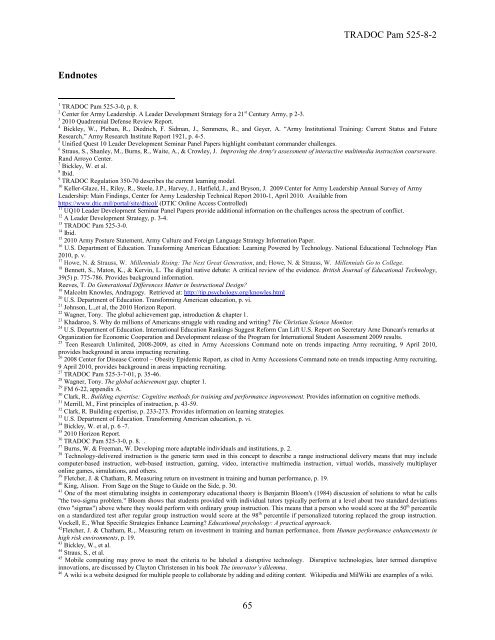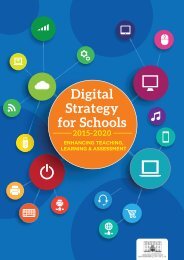K3zgZ
K3zgZ
K3zgZ
Create successful ePaper yourself
Turn your PDF publications into a flip-book with our unique Google optimized e-Paper software.
TRADOC Pam 525-8-2<br />
Endnotes<br />
1 TRADOC Pam 525-3-0, p. 8.<br />
2 Center for Army Leadership. A Leader Development Strategy for a 21 st Century Army, p 2-3.<br />
3 2010 Quadrennial Defense Review Report.<br />
4 Bickley, W., Pleban, R., Diedrich, F. Sidman, J., Semmens, R., and Geyer, A. “Army Institutional Training: Current Status and Future<br />
Research,” Army Research Institute Report 1921, p. 4-5.<br />
5 Unified Quest 10 Leader Development Seminar Panel Papers highlight combatant commander challenges.<br />
6 Straus, S., Shanley, M., Burns, R., Waite, A., & Crowley, J. Improving the Army's assessment of interactive multimedia instruction courseware.<br />
Rand Arroyo Center.<br />
7 Bickley, W. et al.<br />
8 Ibid.<br />
9 TRADOC Regulation 350-70 describes the current learning model.<br />
10 Keller-Glaze, H., Riley, R., Steele, J.P., Harvey, J., Hatfield, J., and Bryson, J. 2009 Center for Army Leadership Annual Survey of Army<br />
Leadership: Main Findings, Center for Army Leadership Technical Report 2010-1, April 2010. Available from<br />
https://www.dtic.mil/portal/site/dticol/ (DTIC Online Access Controlled)<br />
11 UQ10 Leader Development Seminar Panel Papers provide additional information on the challenges across the spectrum of conflict.<br />
12 A Leader Development Strategy, p. 3-4.<br />
13 TRADOC Pam 525-3-0.<br />
14 Ibid.<br />
15 2010 Army Posture Statement, Army Culture and Foreign Language Strategy Information Paper.<br />
16 U.S. Department of Education. Transforming American Education: Learning Powered by Technology. National Educational Technology Plan<br />
2010, p. v.<br />
17 Howe, N. & Strauss, W. Millennials Rising: The Next Great Generation, and; Howe, N. & Strauss, W. Millennials Go to College.<br />
18 Bennett, S., Maton, K., & Kervin, L. The digital native debate: A critical review of the evidence. British Journal of Educational Technology,<br />
39(5) p. 775-786. Provides background information.<br />
Reeves, T. Do Generational Differences Matter in Instructional Design?<br />
19 Malcolm Knowles, Andragogy. Retrieved at: http://tip.psychology.org/knowles.html<br />
20 U.S. Department of Education. Transforming American education, p. vi.<br />
21 Johnson, L.,et al, the 2010 Horizon Report.<br />
22 Wagner, Tony. The global achievement gap, introduction & chapter 1.<br />
23 Khadaroo, S. Why do millions of Americans struggle with reading and writing? The Christian Science Monitor.<br />
24 U.S. Department of Education. International Education Rankings Suggest Reform Can Lift U.S. Report on Secretary Arne Duncan's remarks at<br />
Organization for Economic Cooperation and Development release of the Program for International Student Assessment 2009 results.<br />
25 Teen Research Unlimited, 2008-2009, as cited in Army Accessions Command note on trends impacting Army recruiting, 9 April 2010,<br />
provides background in areas impacting recruiting.<br />
26 2008 Center for Disease Control – Obesity Epidemic Report, as cited in Army Accessions Command note on trends impacting Army recruiting,<br />
9 April 2010, provides background in areas impacting recruiting.<br />
27 TRADOC Pam 525-3-7-01, p. 35-46.<br />
28 Wagner, Tony. The global achievement gap, chapter 1.<br />
29 FM 6-22, appendix A.<br />
30 Clark, R.. Building expertise: Cognitive methods for training and performance improvement. Provides information on cognitive methods.<br />
31 Merrill, M., First principles of instruction, p. 43-59.<br />
32 Clark, R. Building expertise, p. 233-273. Provides information on learning strategies.<br />
33 U.S. Department of Education. Transforming American education, p. vi.<br />
34 Bickley, W. et al, p. 6 -7.<br />
35 2010 Horizon Report.<br />
36 TRADOC Pam 525-3-0, p. 8. .<br />
37 Burns, W. & Freeman, W. Developing more adaptable individuals and institutions, p. 2.<br />
38 Technology-delivered instruction is the generic term used in this concept to describe a range instructional delivery means that may include<br />
computer-based instruction, web-based instruction, gaming, video, interactive multimedia instruction, virtual worlds, massively multiplayer<br />
online games, simulations, and others.<br />
39 Fletcher, J. & Chatham, R. Measuring return on investment in training and human performance, p. 19.<br />
40 King, Alison. From Sage on the Stage to Guide on the Side, p. 30.<br />
41 One of the most stimulating insights in contemporary educational theory is Benjamin Bloom's (1984) discussion of solutions to what he calls<br />
"the two-sigma problem." Bloom shows that students provided with individual tutors typically perform at a level about two standard deviations<br />
(two "sigmas") above where they would perform with ordinary group instruction. This means that a person who would score at the 50 th percentile<br />
on a standardized test after regular group instruction would score at the 98 th percentile if personalized tutoring replaced the group instruction.<br />
Vockell, E., What Specific Strategies Enhance Learning? Educational psychology: A practical approach.<br />
42 Fletcher, J. & Chatham, R.,. Measuring return on investment in training and human performance, from Human performance enhancements in<br />
high risk environments, p. 19.<br />
43 Bickley, W., et al.<br />
44 Straus, S., et al.<br />
45 Mobile computing may prove to meet the criteria to be labeled a disruptive technology. Disruptive technologies, later termed disruptive<br />
innovations, are discussed by Clayton Christensen in his book The innovator’s dilemma.<br />
46 A wiki is a website designed for multiple people to collaborate by adding and editing content. Wikipedia and MilWiki are examples of a wiki.<br />
65




